Urban Gardening Options
Alternative Vegetable Gardens are a great way to start a backyard garden when you do not have a sprawling rural property.

Having a garden full of veggies you love is the main reason so many folks start planting. But if you’re a city dweller or live in the suburbs without a lot of land, gardening might prove to be a challenge.
Don’t worry, you can still enjoy fresh summer produce because there are several different ways to garden that can fit right in with almost any space. If you live in an apartment, condo, or townhouse, you can plant a patio garden or porch garden. And if you have a little bit of land, a straw bale garden or raised vegetable garden may be perfect for you.
How do I start an urban garden?
Urban gardening is all about alternatives, and with so many options, growing vegetables no matter where you live has never been easier. Whether you repurpose a container to grow in or invest in an option that fits your location, fresh tomatoes are definitely something you can enjoy.
Urban Gardening Ideas:
- Old flower pots – These are perfect for herbs or veggies and will grow great on a patio, balcony, or porch garden
- Repurposed containers – Turn an old 5-gallon bucket into the perfect container for growing a tomato plant.
- Window herb garden – You can grow veggies in small containers on a sunny window area. This option means you can enjoy fresh herbs year-round.
- Straw bale garden – Did you know you can grow 3 tomato plants in a single bale of straw? Bales are a great way to grow loads of veggies without sacrificing too much space.
- Raised garden beds – This is a good option if you have a small area outside where you can setup a raised bed.
- Vertical garden – If you are short on space, a vertical garden allows you to grow more by stacking containers. There are many options you can purchase that give you loads of space to grow in.
- Trellis garden – A trellis garden gives you the option of growing vining plants in confined areas. Things like cucumbers, peas, even canteloupe.
- Indoor garden – There are many options for growing vegetables indoors using hydroponic systems.
Let’s take a look at some of these different ways to urban garden and break them down a bit more.
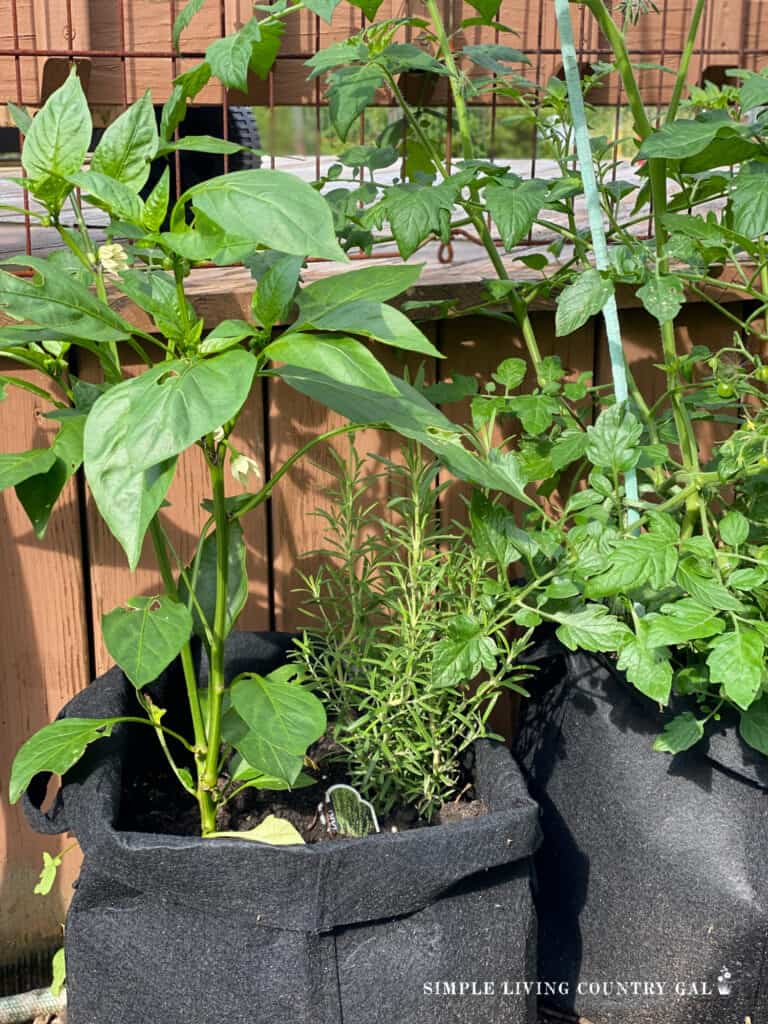
Urban Gardening
Containers are your friend when looking for alternative gardening options. If they’re large enough to allow the roots to grow without restriction and have ample drainage, they are an option to consider. Let’s look at some alternatives for gardening.
Patio Garden/Porch Garden/Balcony Garden
These types of gardens are perfect for apartment, condo, and townhouse dwellers. They don’t need a lot of space, and you can plant a variety of vegetables, fruits, and herbs by combining various containers.
Before you start planting there are a few things to consider before you begin.
#1. Sun
When growing on a patio or porch you will want to be sure the area gets plenty of sunshine, at least 6-8 hours a day.
#2. Water
You will also want to ensure there is a convenient way to water. While a watering can will work, a small garden hose is best especially if you have quite a few plants. During the growing season and on excessively hot days, your plants will need to be watered more often to keep them healthy and make sure they produce a quality harvest.
One more tip to consider is before planting, be sure that your balcony or porch can handle the weight of several heavy pots filled with soil. You may also want to check the guidelines of your building management to make sure you’re allowed to have plants and produce growing where you live.
Containers for a Patio Garden
There are quite a few options you can use to grow in. Just know that if it can grow in a traditional garden, it can grow in a container. Let’s look at a few of our top picks.
Grow Bags
Grow bags are a great option if you have no containers to grow in. They come in a variety of sizes, are priced quite reasonably, and are durable enough to last multiple years. Simply fill them with soil, plant according to the plant’s or seed packet instructions, and place them where they will get enough sun.
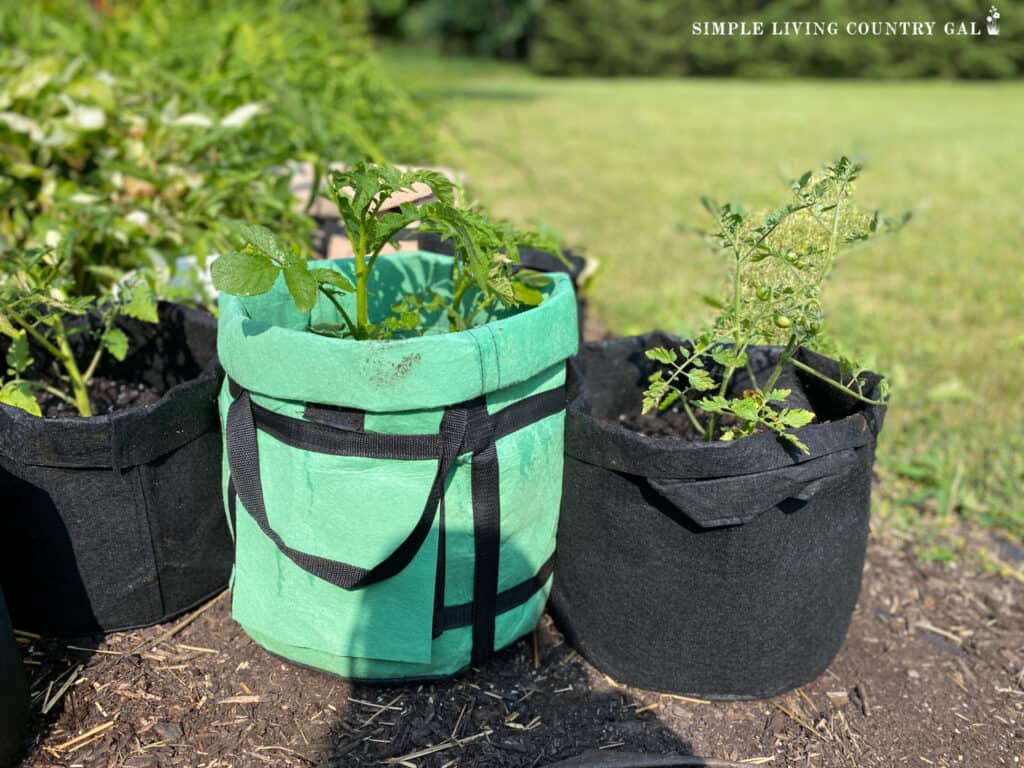
Some grow bags have a small window on the side which is great for root vegetables. It allows you to take a look below the soil and see if your carrots or potatoes are ready to harvest.
3-Pack 7 Gallon Potato Grow Bags with Harvest Window, Garden Plant Growing Bags with Flap and Handles, Thickened Nonwoven Fabric Plant Pots Grow Bags for Potatoes, Tomato, Vegetable and Fruits


Window Boxes
If you love herbs, then you may want to try window boxes. These are long planters that hang on the side of a balcony railing. They are a bit shallow, but that is all you need to grow a wide variety of delicious herbs. Since the roots of these plants are smaller, they do not require a lot of space to grow, and the roots don’t need more than a few inches of depth.
Harmiden 4 Pcs 30“ Window Box Deck Railing Planter with Coco Liner for Outdoor Balcony Porch Fence Patio Rail


Hanging Grow Bags
Another gardening option to consider is hanging grow bags. These are great for growing tomatoes, strawberries, and other fruits and veggies. You can hang these types of planters from a porch ceiling or other overhang, allowing you to take advantage of additional space. You can also place a metal grid against a wall to hang baskets.
Betereap Upside-Down Tomato Grow Bag – 2-Pack Widen Planting Holes 400G Heavy Duty Easy Installation Durable Hanging Tomato Planter for Small Spaces with Carabiner Clip Design


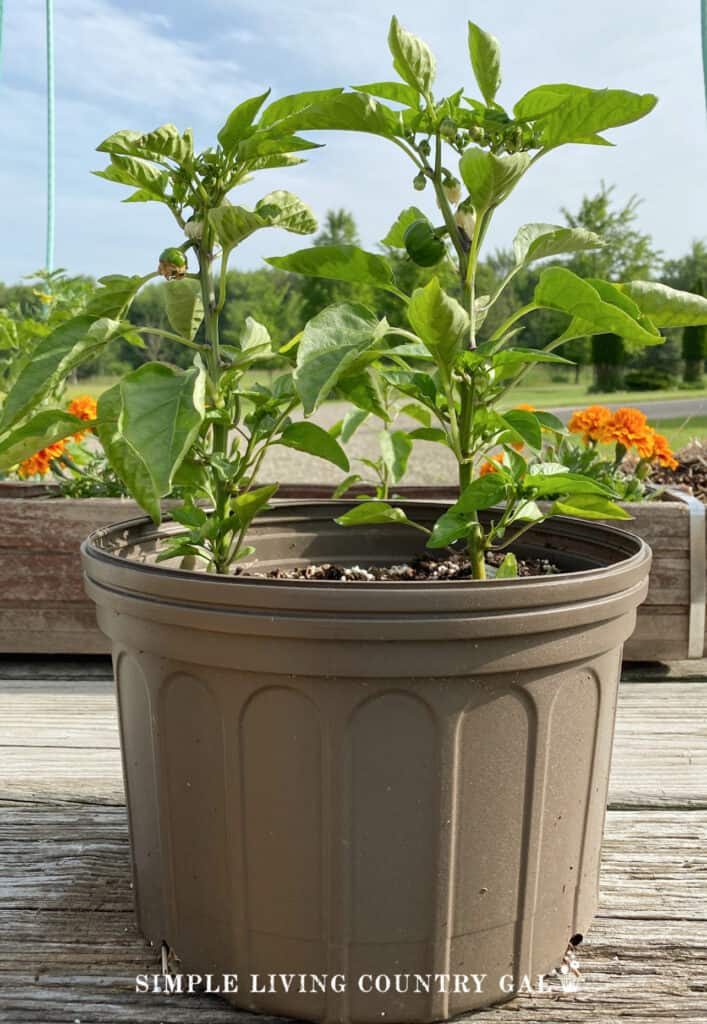
Table Gardens
Table gardens are great options for people with knee issues, back problems, or other physical limitations. You can easily garden while sitting in a chair opening up a world of possibilities if you struggle physically.
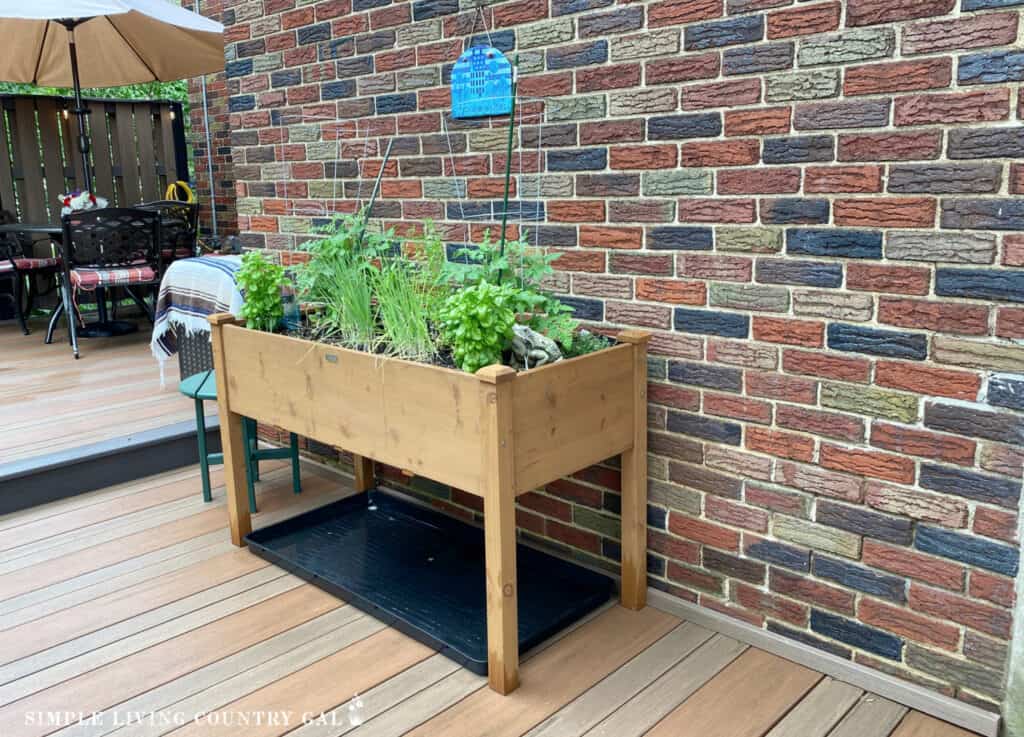
Flower Pots
Repurposing old flower pots is a great way to grow vegetables without much cost. Dig out some of your pots, give them a good wash and rinse, and you can fill it with soil and begin planting.
Another bonus is repurposed flower pots can be placed on stands or benches, bringing them up even higher so that you can avoid bending and kneeling altogether.
My favorite place to grow our garden is on an old picnic table. I can put containers on the bench areas along with more containers on the top. One picnic table can provide us with enough food to enjoy throughout the summer.
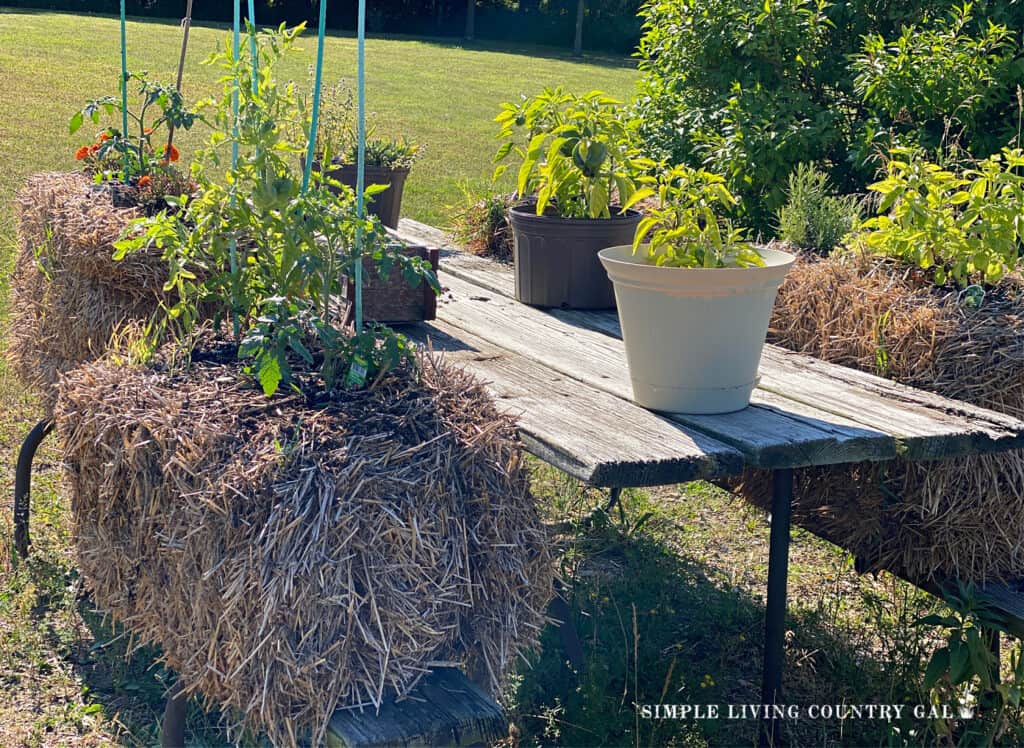
More Container Growing Guides:
- Grow Cherry Tomatoes in Containers
- How to Grow Herbs in Containers
- How to Grow Peppers in Containers
Containers come in various shapes and sizes, so they’re easily adaptable to the amount of space you have and the types of vegetables you want to grow.
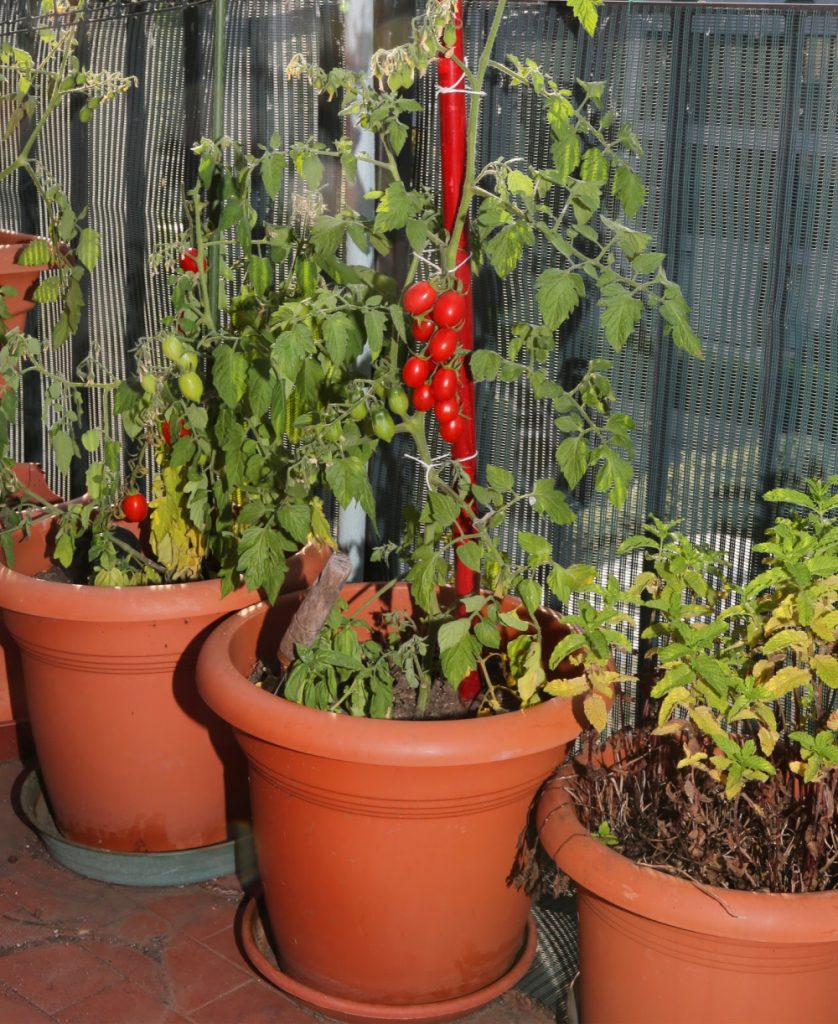
Grow bags and containers can be placed in almost any space on a patio, on a lawn, or even on a set of stairs.
Containers are less susceptible to weed growth than a traditional backyard garden. And although they can still attract pests, they’re easier to control. Some pests, like slugs, won’t be able to reach your plants if they are inside containers, making them a great option.
Window Garden for herbs and small veggies
If you don’t have enough space outside or access to a patio, you may want to consider growing a window sill garden. Although compact you can still enjoy fresh herbs or even salad ingredients like radishes or lettuce.
Location – First, you will need to find a window with a good amount of sunlight each day. If not, you can invest in a grow light for overcast days.
Plants – Next, decide how many herbs/veggies you want to grow so you can purchase the correct sized containers. Remember to repurpose any small flower pots being sure to wash them before using.
If you are growing herbs, you can give them each their own container or grow a cluster in a larger pot. If you want to grow a salad garden, a long container may work better, giving you one large area for everything to grow in.
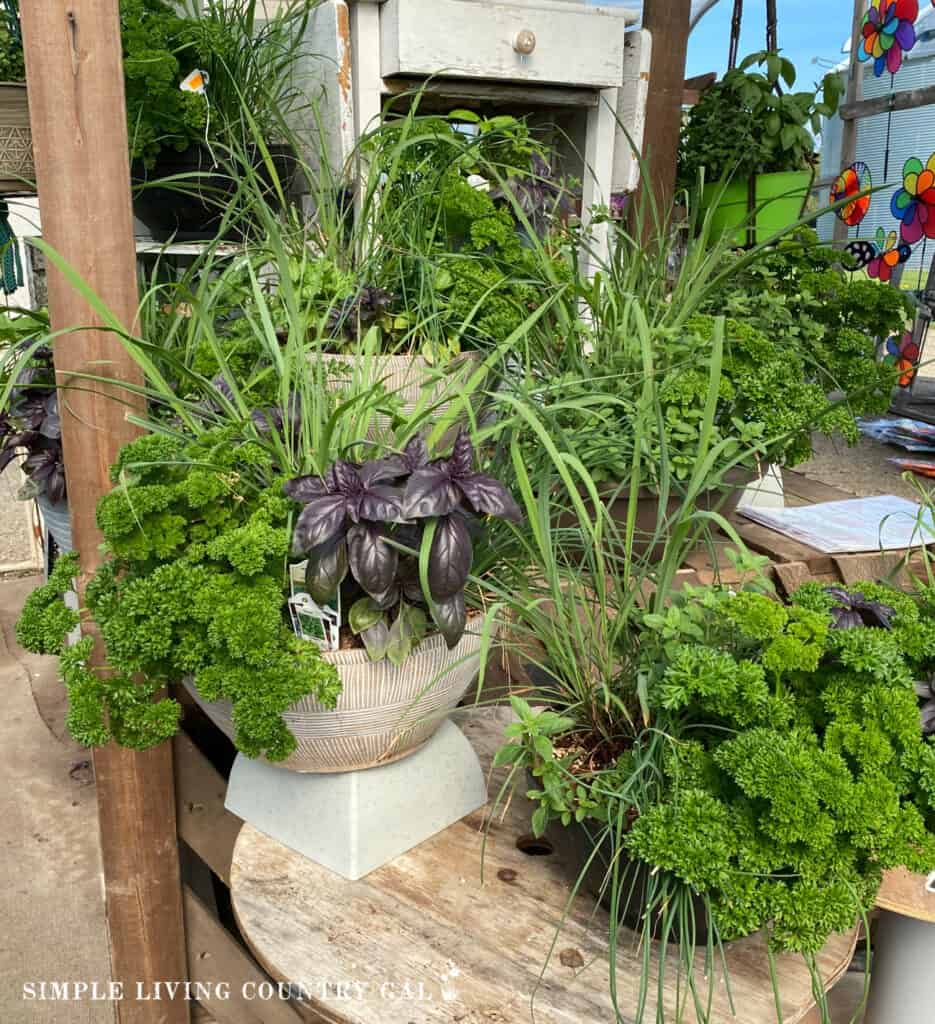
When setting up a window garden, start with your containers. You can purchase individual pots, a kit that includes pots and drainage trays, or you can make your own.
DIY Window Garden
You can turn any container into a window garden. The main things to look for is that the container has enough space for growth and there is enough drainage for excess water.
How to Add Drainage to a Container:
- Using a hammer and nail, nail through the bottom of each can to create drainage holes so excess water can drain out.
- Next, wash the container thoroughly to remove any residue.
- Place each container on a tray to catch any water that drains out.
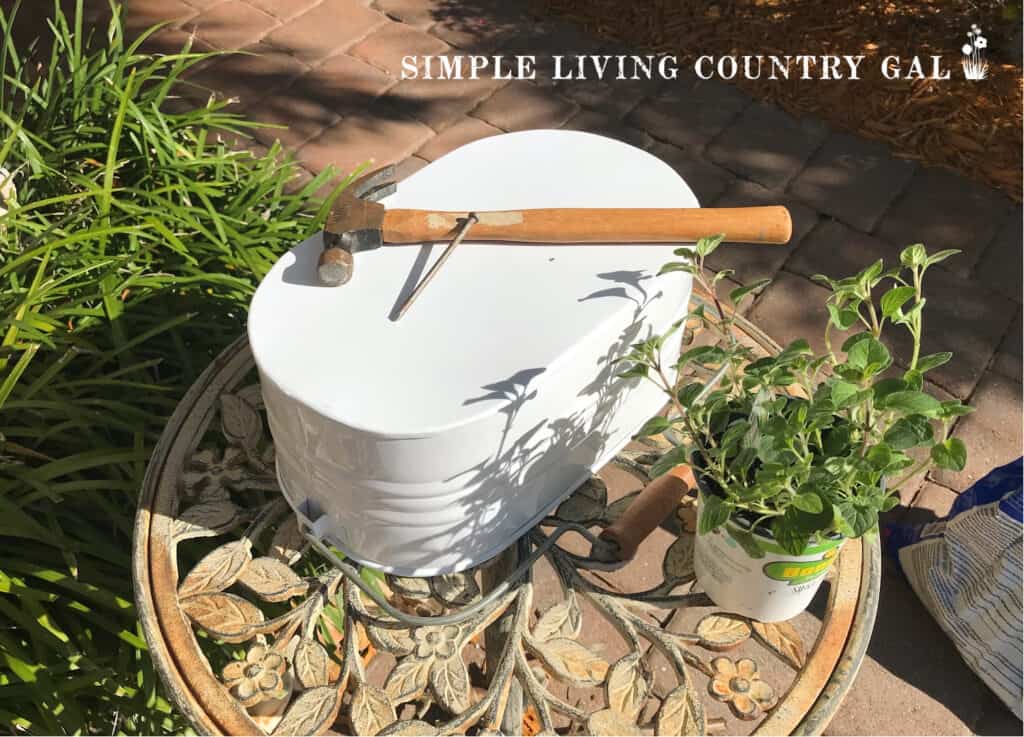
How to Plant DIY Containers
No matter what container you choose to use, the planting steps will be the same. If you are starting late in the season, you can purchase seedlings from your local nursery to jump-start growing plants in a container.
- Add potting soil first. Be sure to use good organic quality soil.
- If using seeds, follow the packet instructions for depth and spacing.
- If using seedlings, remove the plant, being careful to keep the soil intact.
- Using your hands, hold the seedling over the container and gently break up the roots.
- Place the seedling in the soil, ensuring it is at the right depth.
- Add enough soil to hold the plant securely in place.
- Lightly tap the soil down with your hands.
- Water your plant being sure not to overwater.
Once planted, place your container garden in a window that receives at least 6 to 8 hours of direct sunlight daily. Remember to water regularly and remove any dead or dying leaves so the nutrients reroute to healthy parts of the plant.
With proper maintenance, your window herb garden will provide you with plenty of herbs in no time.
Straw Bale Gardens
If you want more room to grow, consider using bales of straw. This unique way of gardening is quickly becoming popular in many urban areas. All you need is a bale of straw, and you can grow three tomato plants or four pepper plants right outside your kitchen door.
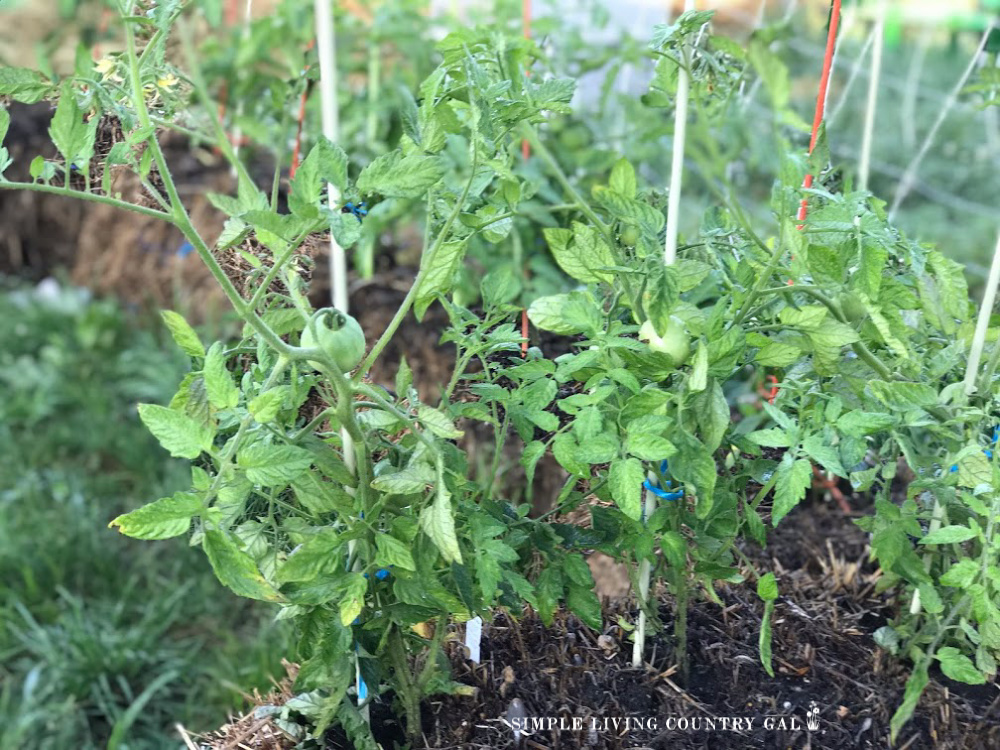
One thing to keep in mind with this gardening method, you must use straw and not hay. Hay tends to have seeds along with weeds, and that is not the best environment to grow vegetables in. Instead, be sure to use straw as it only contains the stalk of the plant.
Straw bale gardening is a natural way to grow a vegetable garden. When the season is over, you can put the bales in a pile to compost over winter. Like any other gardening method, the bales will need to be placed in a bright, sunny area and need regular watering. Once properly conditioned, you can grow almost any vegetable or fruit in a straw bale garden.
Straw Bale Gardening Help:
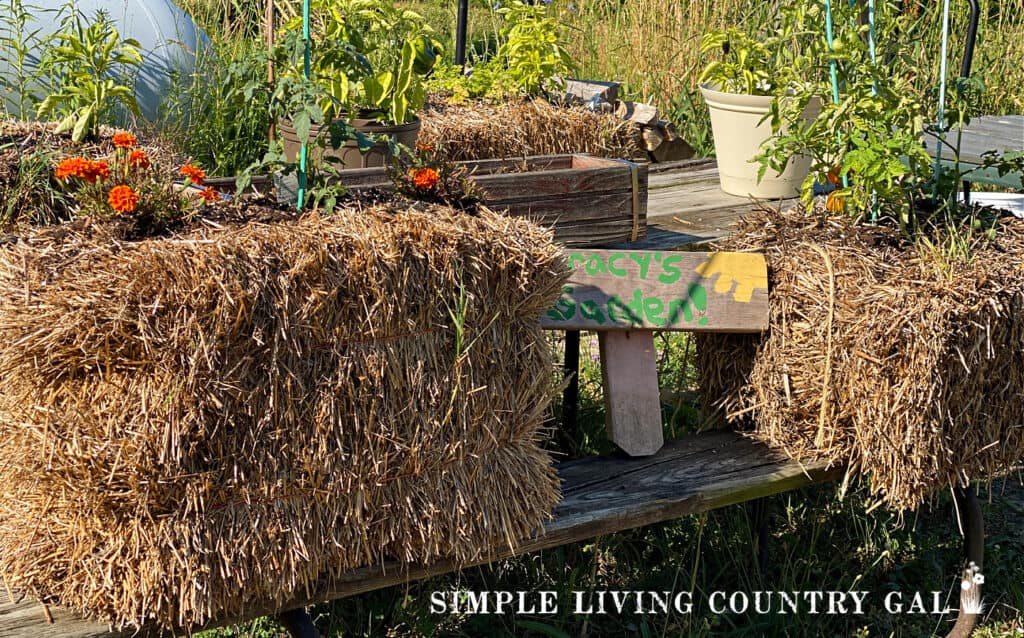
Vertical Garden and Trellis Garden
Vertical gardens can be grown against the side of a wall or fence using a simple wall hanging pocket planter. This is a great option to consider if you are limited on space. Find a planter that works in your area and matches your style. Have fun with your setup so you enjoy your growing adventure.
The options for vertical planters are endless: from a well-built wooden planter system to a recycled wooden pallet or even a setup made with upcycled plastic soda bottles.
This Vertical Wall Garden Planter is another vertical solution for gardening. It’s both cost-effective and efficient. It allows you to grow a variety of shallow-root plants like lettuce, herbs, and even radishes.
Finally, a vertical garden is not only a great space-saver, but it can also be used to create a privacy screen for your neighbors. It’s also a great option for people with back or knee problems, as you won’t need to spend time on the ground to plant, maintain, or harvest.
Vertical gardens are perfect for fruits, vegetables, herbs, and flowers, so you’re not limited by what you can grow; if you want to grow it, you can.
Indoor Garden
If you’re not looking for a large harvest or don’t have an outdoor space, an indoor garden may be a good option for you as long as you have quality lighting.
Remember that sunlight can be challenging for an indoor garden, so consider choosing an out-of-the-way area to set up your garden and adding some grow lights instead. Beets, carrots, lettuce, herbs, and spinach can all be easily grown indoors.
You’ll need your containers to be at least 4 inches deep (6 inches for carrots). Fill with organic, all-purpose potting soil. Once done, you can then plant your seeds following the packet instructions or transplant seedlings following the plant guide for depth and spacing.
Indoor gardens may need a little more planning than outdoor gardens due to space constraints. Think about what you want to grow, what location in your home will work best, and the size pots you’ll need before getting started. If you need to include grow lights, consider those when planning the size of your space.
PERFNIQUE Indoor Herb Garden, Herb Garden Planter for Indoor/Outdoor, Farmhouse Plant Pots, Windowsill Herb Garden with Tray(Planter only) Window Pots


Indoor Garden Resources:
The nice thing about indoor gardens is that you don’t have to worry about any of the outdoor elements like pests, extreme hot or cold weather, or too much or too little rain. You can grow a bountiful garden all year long regardless of the outdoor conditions.
Questions to Ask Yourself Before Planting Your Urban Garden
Before you head out to the store, consider these questions. All are meant to help you choose the best containers for the setup.
How big is your space?
Even a small space can accommodate a garden if you think about it from all sides. Do you have space for containers and window boxes? If not, you may want to consider a vertical garden or a window garden.
How much sun does the area get?
Your garden area will need at least 6 to 8 hours of sun to grow a fruitful garden. Many people tend to overestimate how much sun their area gets. To properly measure this, calculate the sun on a day when you’ll be home all day.
Check the space hourly to see if it’s getting full sun, partial sun, or no sun at all. Then determine how many hours your proposed garden area was in full sun.
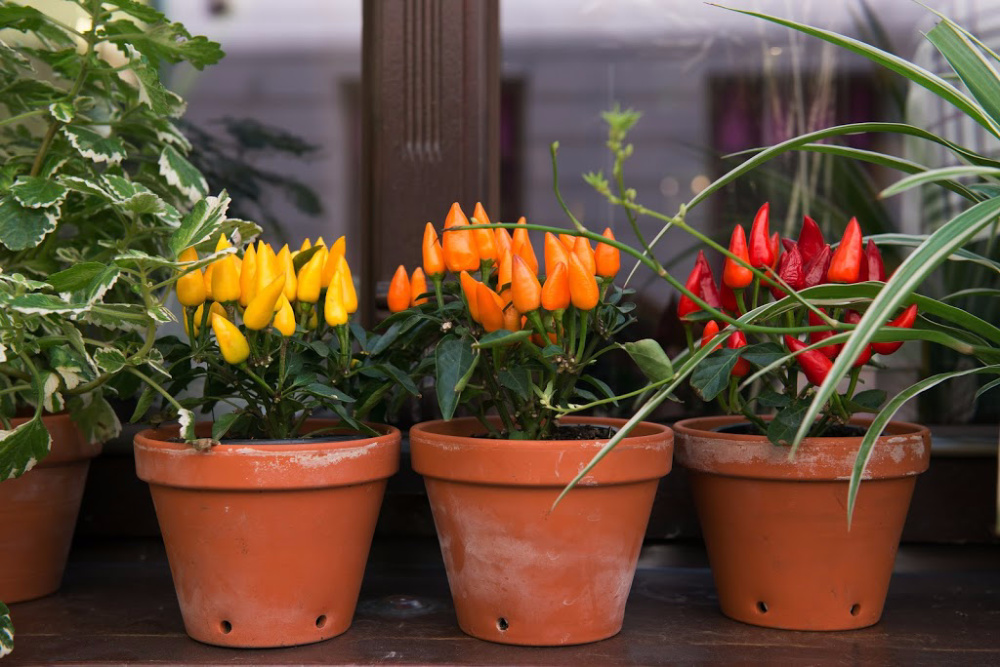
How hot or cold does the area get?
Extreme heat means more watering, so you’ll want to think about how hot it gets, specifically in the area of your proposed garden, on any given day. The same can be said for cold weather.
A frosty night can kill your plants. If your area experiences a lot of these, you may want to plan a container garden that can be brought inside on a frosty night.
CJGQ Plant Covers Freeze Protection, 0.9oz 10x50FT Frost Cloth Plant Freeze Protection, Plant Frost Blankets Covers for Outdoor Plants for Winter Cold Weather, Floating Row Cover for Vegetables


Does it get windy?
Balconies of high-rise buildings can experience a lot of wind, which can damage plants and cause them to dry out faster. If you live in an apartment or condo and you’re planning a balcony garden, this is something to consider.
Do you have water access?
This is important because many plants will need to be watered twice a day during the growing season. This can be a hassle if you’re planning for lots of pots or raised beds and you’re only using a watering can. Hose access is best if possible.
With so many different ways to garden, you should be able to find one that works well for you regardless of the amount of space and sunlight you have available. Even with so many vegetable garden types, as long as they’re well maintained, and get plenty of water and sunlight, they should grow well in almost any area.

Gardening is not only a great way to enjoy healthy, organic produce, it’s also a great hobby that provides relaxation and calm. And, it allows you to ensure that your favorite produce is available all year long.
With a little planning and some of these urban gardening options, you can grow a nice garden in almost any small or large area around your home. It doesn’t matter if you only have a small balcony or windowsill or a large patio; a healthy garden can grow almost anywhere.
More Gardening Resources:
Find this post and more at the Homestead Bloghop!





















Growing veggies in vertical and hydroponically can be trilling and challenging at the same time.
As a new gardener I think growing plants in buckets is ideal way to kick start urban gardening.
Thanks for your informative article.
Yes, buckets are a great way to get started gardening in containers!